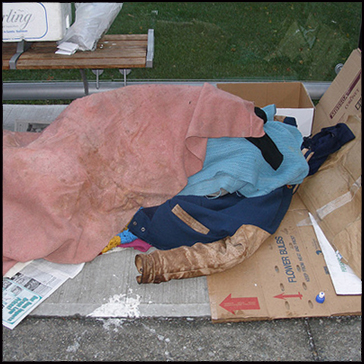
The concept of a hate crime has to do with civil rights, identity politics, and quite a few other sociological factors. The idea is that although it is wrong to hurt or kill a person, it is especially wrong to hurt or kill a person just because of their skin color, sexual or religious orientation, or other defining characteristic, depending on the jurisdiction. When people are at risk of being hurt or killed for the hate motive alone, they can be legally deemed a Protected Class, meaning that if the assailant is caught and tried, the penalty ought to be extra tough.
Why do we need the Protected Homeless Class Resolution? Briefly, because some people just simply have no alternative to living in public places. Their ordinary actions are criminalized by the authorities. Uniformed enforcers show up, and are seen to harass or brutalize the homeless. This example encourages every cowardly hater in the area to conclude that it’s okay to prey upon the homeless. Some of these bozos even talk themselves into believing they are doing the world a favor by eliminating the homeless as if they were vermin. On city streets or in rural homeless encampments, women are more vulnerable than men. Their numbers are fewer, and nature has not equipped them for effective self-defense. Objectified and depersonalized, they make attractive victims.
Last week, a homeless woman who occupied the hallway of a Milwaukee apartment building was beaten to death with a brick. From El Paso, Texas, Daniel Borunda reported on the issuing of an arrest warrant for a murder. In March, the body of Venus Sloan Driscoll was found in a desert lot. Driscoll had lived in a tent, and the fact that she apparently was killed by another person experiencing homelessness does not lessen the horror of this crime. In a properly functioning society, both killer and victim would have been somewhere else, doing something else with their lives.
Mid-April, in New Orleans, Chantell Christopher’s body was found under a highway exit ramp. She was beaten to death, and the crawlspace where her body was found was actually also where she lived. Jarvis DeBerry, editorial writer and columnist for The Times-Picayune, tells us that a grieving crowd attended a memorial service for Christopher in the garden of a church last Thursday afternoon. She was mentally ill, and somewhere, two children survive her. To find out more about homelessness as background for his story, DeBerry interviewed clients of a program called Ciara Community Services and Permanent Housing. One of his informants was, like Christopher and so many other people experiencing homelessness, mentally ill. But he was sufficiently in touch with reality to understand that, even if he contacted family members, they too were probably just hanging on in this terrible economy.
It’s like that for a lot of street people, even if they have others who care. The friends and family members are struggling themselves and can’t really do much, except shoulder the added burden of feeling bad about being unable to help. And some, whether rightly or wrongly, have too much pride to reveal that they are homeless, or to ask for help. Apparently, Christopher had not let her family know the depth of her troubles. The writer says,
Put Chantell’s, Cyril’s and William’s stories together, and you’re struck by their determination to make it without anybody’s help — even though help is necessary for anybody trying to overcome the challenges of mental illness.
From Austin, Texas, Chris Sadeghi relayed the news of a homeless woman found in a storage unit, after spending two days there with head injuries and a broken leg. The space was rented by a man who probably used it as living quarters, and he felt entitled to punish his victim for behavior that didn’t please him. Reportedly, he bashed her head against a concrete surface nearly 20 times. Sadeghi sought out Richard R. Troxell of House the Homeless, who explained the unfortunate tendency of people to look for such unorthodox living arrangements:
We are talking about the need to have safe decent affordable housing and it is not available at the wage people are being paid. So people are looking for alternatives and sometimes they are not the best alternatives.
These are exactly the kinds of situations that Richard’s Protected Homeless Class Resolution (PHCR) was created to prevent. It contains these words:
THERFORE, BE IT RESOLVED: That persons without a fixed, permanent, individual place of residence, and those that are earning 100% of Federal Poverty Guidelines or less, are sufficient in number characteristics, and vulnerability to compromise a distinct class of people, and as a result, shall hence forth constitute a Protected Class with all rights and protections under such a designation. Herein after, this Protected Class, will be referred to as the Indigent Homeless Population.
The PHRC would protect the indigent homeless from being treated as second-class citizens or non-citizens. It would protect them from laws against sleeping in public, and add extra to the penalties imposed on predators who take advantage of people who have no choice but to sleep in public. Hopefully, it would go some way toward decreasing the number of hate crimes. The PHRC has been adopted by the National Coalition for the Homeless, but not by any city, state or the federal government… yet.
Reactions?
Source: “Homeless woman beaten to death in Milwaukee,” The Examiner, 04/24/11
Source: “Suspect sought in slaying of homeless woman,” El Paso Times, 04/16/11
Source: “At memorial for New Orleans murder victim, a heavenly hope takes on new meaning,” The Times-Picayune, 05/01/11
Source: “Woman beaten, locked in storage unit,” KXAN.com, 04/29/11
Image by quinet (Thomas Quine), used under its Creative Commons license.


